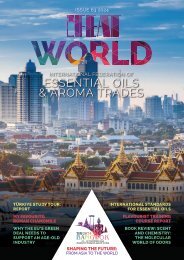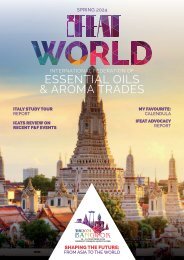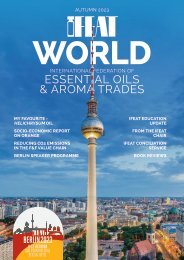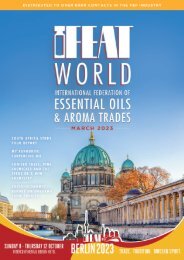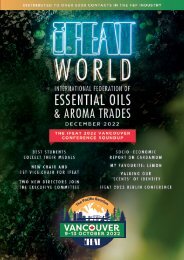IFEATWORLD July 2022
A Members' Newsletter for the International Federation of Essential Oils & Aroma Trades.
A Members' Newsletter for the International Federation of Essential Oils & Aroma Trades.
Create successful ePaper yourself
Turn your PDF publications into a flip-book with our unique Google optimized e-Paper software.
28<br />
WORLD<br />
IFEAT SOCIO–ECONOMIC REPORT ON CEDARWOOD OILS<br />
for its beneficial effects on children<br />
with ADHD, with cedarwood oil found<br />
to decrease hyperactivity and evoke a<br />
calm, almost sedative quality reducing<br />
the stress and anxiety that comes<br />
along with the disorder. Also, the oil has<br />
been registered with the US EPA as a<br />
pesticide that stops moths from eating<br />
clothing.<br />
The timber from the wide range<br />
of junipers (Juniperus), cypresses<br />
(Cupressus spp.) and true cedar trees<br />
(Cedrus) have a range of other non-oil<br />
uses such as timber, furniture, fencing,<br />
pencil making, ornamental trees,<br />
and railway sleepers. This is briefly<br />
discussed in the individual country<br />
sections.<br />
All the cedarwood oils of commerce<br />
contain a group of chemically related<br />
compounds, the relative proportions<br />
of which depend on the plant species<br />
from which the oil is obtained. These<br />
compounds include cedrol and<br />
cedrene, and while they contribute<br />
something to the odour of the whole<br />
oil, they are also valuable to the<br />
chemical industry for conversion<br />
to other derivatives with fragrance<br />
applications. The oils are therefore<br />
used both directly and as sources of<br />
chemical isolates, including alpha<br />
cedrene epoxide, methyl cedryl ether<br />
and cedryl acetate.<br />
Virginiana cedarwood oil is considered<br />
by many perfumers to have a smoother<br />
and finer (but less powerful) odour<br />
than Texas oil. In addition, it is used<br />
in insecticides, polishes and cleaning<br />
products, soaps, liniments, and<br />
cedarwood still residues have been<br />
used in the manufacture of linoleum. A<br />
sizeable proportion of the oil is used as<br />
a starting material for cedrol and cedryl<br />
acetate.<br />
Chinese oil has a lower cedrol content<br />
than American oils and is used more in<br />
its own right as a fragrance oil than as<br />
a source of chemical isolates. The oil<br />
and wood are used to prepare incense<br />
in China.<br />
The uses of Moroccan cedarwood oil<br />
(Cedrus atlantica), Indian cedarwood<br />
oil (Cedrus deodara) also known as<br />
Himalayan cedarwood oil, Japanese<br />
hinoki oil (Chamaecyparis obtusa),<br />
and Canadian cedarleaf oil (Thuja<br />
occidentalis L.), are discussed in Part 2.<br />
An important constituent of cedarwood<br />
oils is cedrol, which is used in flavours<br />
and fragrances as well as being<br />
used to make a range of chemical<br />
derivatives such as cedrol methyl<br />
ether, cedryl acetate and other esters.<br />
The sesquiterpene hydrocarbon<br />
fractions are commercially chemically<br />
derivatised to make fragrance<br />
ingredients like acetyl cedrene and<br />
cedr-8-ene epoxide. These are all<br />
important high-volume ingredients<br />
for the global fragrance industry. After<br />
processing, the derivatives produced<br />
and their formulated products have a<br />
more diverse range of markets.<br />
Commercial cedarwood oils are<br />
vacuum rectified from the steam<br />
distilled crude oil, to give oils of a very<br />
pale-yellow colour. During rectifying<br />
crude oil, the fractions are water – top<br />
fraction (alpha pinene etc.) – cedrene<br />
– liquid cedrol – residue. Then cedrene<br />
and liquid cedrol are blended into<br />
commercial cedarwood oil based on<br />
customers’ specifications. Liquid cedrol<br />
turns into solid cedrol at below 60°C<br />
and can be made into commercial<br />
cedrol by being centrifuged and dried<br />
and its melting point is about 80°C.<br />
Cedrene is also being used separately<br />
to make MCK (methyl cedryl ketone<br />
and cedrol into methyl cedryl ether,<br />
while there is a mixture of cedrene and<br />
cedrol in cedryl acetate.<br />
Further processing of the crude oil<br />
takes place through rectification which<br />
produces fractions with different<br />
olfactory properties and isolates with<br />
individual constituents for derivative<br />
manufacture. This is undertaken either<br />
by producers in China or the USA,<br />
where there is large scale production<br />
and sizeable domestic consumption, or<br />
by end-users in importing countries in<br />
Europe and Japan.<br />
QUALITY AND<br />
COMPOSITION<br />
Both the overall olfactory properties<br />
and the chemical composition<br />
of cedarwood oils are important<br />
quality characteristics. The olfactory<br />
properties will be assessed by some<br />
purchasers since they are vital for its<br />
use in fragrances, while its chemical<br />
composition is vital for use as a raw<br />
material in derivative manufacture.<br />
Texas cedarwood oil shares many of<br />
the same constituents as Virginiana<br />
cedarwood oil detailed below:<br />
cedrol, alpha cedrene, beta cedrene,<br />
thujopsene, cuparene, various<br />
chamigrenes, widdrol, and pinenes,<br />
but Texas oil usually tends to show<br />
higher levels of cedrol, with the highest<br />
content being in the crude oil from<br />
the continuous distillation process at<br />
40% or more. Despite having similar<br />
components to Virginiana, the Texas<br />
cedarwood tends to smell more<br />
woody and less oily, with much of<br />
the differentiation in smell occurring<br />
in the minor compounds of the oil.<br />
Because of the presence of these<br />
minor compounds and separate odour<br />
profiles, Texas cedarwood oil tends<br />
to have uses in the fragrance market<br />
that are distinct from Virginiana oil.<br />
Additionally, there is a growing use<br />
for Texas cedarwood oil in natural<br />
insect repellents and pesticides, and<br />
the pesticidal properties of the oil are<br />
also considered to come from the<br />
combination of minor compounds<br />
in the natural oil, and not from one<br />
individual constituent.<br />
The crude Texas cedarwood oil is a<br />
dark orange to brown, turbid, semiviscous<br />
liquid from which crystals<br />
can separate on standing, particularly<br />
during winter. It has a pleasant odour,<br />
sweet woody but a little smoky and<br />
only used for further processing.<br />
The almost colourless non-smoky<br />
rectified fractions are used to make<br />
consistent “standardised oils” to meet<br />
customer specifications, dependant<br />
on applications. These are mostly in<br />
fragrance materials for use in soaps,<br />
candles, room sprays and floor<br />
polishes.<br />
The main constituents in Virginiana<br />
cedarwood oil include cedrol, alpha<br />
cedrene, beta cedrene, thujopsene,<br />
and minor amounts of widdrol,<br />
chamigrenes, and other pinenes. The<br />
relative amounts of these compounds<br />
can vary with distillation cook time,<br />
temperatures, and raw material<br />
conditions. It is common to do some<br />
further processing of the crude oil,<br />
with limited need for fractionation and<br />
blending, to standardise colour and<br />
specifications. Generally, a redistillation<br />
will remove around 2%-3% of wood<br />
rosins, which can account for colour<br />
variations between batches.<br />
The rectified Virginiana cedarwood<br />
oil is an almost colourless oil, sweetly<br />
balsamic, non-smoky smelling and<br />
is considered by many perfumers as<br />
the finest of the cedarwood oils. This<br />
is reflected in its main application in<br />
fragrances intended for use in furniture<br />
polish (rather than floor polish),<br />
cosmetics, shampoos, aftershaves,<br />
incense, and aromatherapy. It has a<br />
premium price in the marketplace, and<br />
as a result is used as produced rather<br />
than made into derivatives.<br />
International (ISO) standards exist<br />
for Texas and Virginiana cedarwood<br />
oils. For Texas oil an alcohol content




